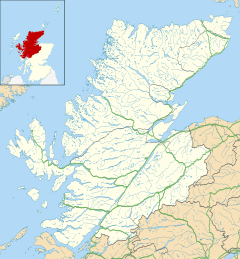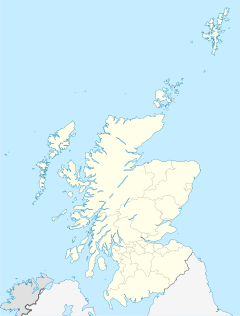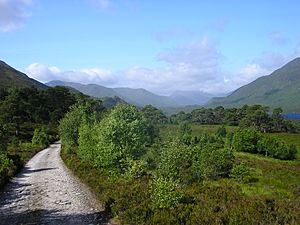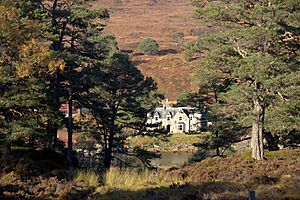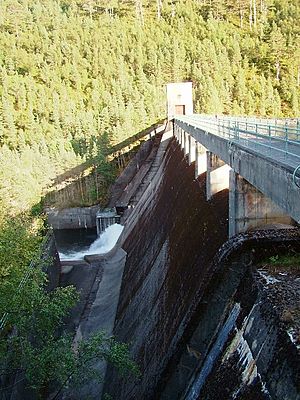Glen Affric facts for kids
Quick facts for kids Glen Affric National Nature Reserve |
|
|---|---|
|
IUCN Category II (National Park)
|
|
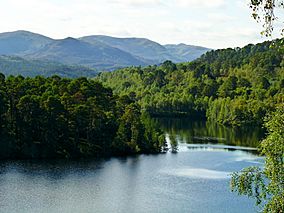
Pinewoods at Loch Beinn a' Mheadhoin
|
|
| Location | Cannich, Highland, Scotland |
| Area | 145 km2 (56 sq mi) |
| Designation | NatureScot |
| Established | 2002 |
| Operator | Forestry and Land Scotland |
| Glen Affric National Nature Reserve | |
Glen Affric (which means Gleann Afraig in Scottish Gaelic) is a beautiful glen (a narrow valley) in the Highland region of Scotland. It's located southwest of the village of Cannich, about 15 kilometres (9.3 miles) west of Loch Ness. The River Affric flows through the glen, passing through two lochs: Loch Affric and Loch Beinn a' Mheadhoin. A small public road goes as far as Loch Beinn a' Mheadhoin. After that, you can only explore the glen using rough tracks and footpaths.
Many people say Glen Affric is the most beautiful glen in Scotland. It is home to the third largest area of ancient Caledonian pinewoods in the country. You'll also find stunning lochs, open moorland, and tall mountains here.
This special area is protected in many ways. It is a Caledonian Forest Reserve, a National Scenic Area, and a National Nature Reserve. The forests, open spaces, and mountains make Glen Affric a popular spot for people who love to hike, climb, and mountain bike.
Contents
Plants and Animals of Glen Affric
Glen Affric is famous for its ancient Caledonian pinewoods, which are among the oldest forests in Scotland. These woodlands are so important that Glen Affric was made a National Nature Reserve in 2002.
The forest is mostly made up of Scots pine trees. But you can also find other trees like birch, rowan, aspen, willows, and alder. On the forest floor, many unique plants grow, such as creeping ladies tresses, lesser twayblade, and twinflower. You can also spot several rare types of lichens growing on the trees.
Scots pine trees first grew here after the last Ice Age, thousands of years ago. The oldest trees you see today are tough "granny" pines that survived past logging. For a long time, new trees struggled to grow because there were too many sheep and deer eating the young plants. In the 1950s, the Forestry Commission started planting new trees. At first, they used some non-native trees like Sitka spruce and lodgepole pine. However, since the 1980s, they have focused on removing these non-native trees and plants like rhododendron to help the native forest grow back.
Today, Forestry and Land Scotland (FLS) works to help the pinewoods recover. They control the number of deer, which helps young trees grow without needing fences. Fences can sometimes harm birds like black grouse and capercaillie. The goal is to create a network of forest habitats with new forest areas connecting the old ones. They also want to create a "treeline transition zone" where the forest gradually changes into mountain heath, with shorter, twisted trees and low shrubs.
Thanks to nearly 70 years of careful management, the variety of life in Glen Affric has improved. The reserve is now home to many birds, including black grouse, capercaillie, crested tit, and Scottish crossbill. You might also see large birds of prey like ospreys and golden eagles. Glen Affric is also a home for Scottish wildcats and otters. The bogs and lochs are perfect for many types of dragonflies, including the rare brilliant emerald.
In 2019, a special elm tree in Glen Affric was named Scotland's Tree of the Year by the Woodland Trust. People called it the "Last Ent of Affric."
History of Glen Affric
Glen Affric was once owned by powerful Scottish families, the Clan Chisholm and the Clan Fraser of Lovat, from the 1400s to the mid-1800s. The ownership of the glen sometimes led to arguments, like the Battle of Glen Affric in 1721.
A famous piece of tartan fabric, called the "Glenaffric Fragment," might date back to the late 1600s.
In 1846, Dudley Marjoribanks, a wealthy politician, leased the hunting rights in Glen Affric. By 1856, he bought the entire Glen Affric Estate, which was over 32,000 acres (13,000 ha). He built a large hunting lodge, which looked like a castle, and even a whole village called Tomich.
Lord Tweedmouth was also famous for creating the first golden retrievers at his kennels near Guisachan House. These dogs were excellent at helping with hunting parties he hosted at Glen Affric Lodge.
Later, his son, Edward Marjoribanks, 2nd Baron Tweedmouth, inherited the estate. His wife, Lady Fanny Spencer-Churchill, was known as the "Lady of Glenaffric" and also loved golden retrievers. She passed away at Glen Affric Lodge in 1904.
Important visitors came to the estate, including the Duke and Duchess of York (who later became King George V and Queen Mary) in 1897. Lady Tweedmouth's nephew, Winston Churchill, also visited in 1901 and enjoyed learning to drive a car on the grounds.
The Marjoribanks family owned the estate until 1909. Over the years, different owners bought and sold parts of Glen Affric. In 1948, a large part of the land was sold to the Forestry Commission.
Who Owns Glen Affric Today?
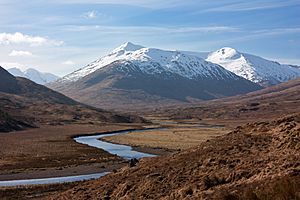
Most of Glen Affric was bought by the Forestry Commission in 1951. Today, Forestry and Land Scotland (FLS), which took over from the Forestry Commission, is the biggest landowner. They manage about 176 square kilometres (68 sq mi) of the lower and central parts of the glen.
The National Trust for Scotland has owned the West Affric Estate, which covers the upper part of the glen, since 1993. This area is about 37 square kilometres (14 sq mi).
As of 2019, a private owner, David Matthews, owns the North Affric Estate. This estate covers 36 square kilometres (14 sq mi) on the north side of Loch Affric and includes the large Affric Lodge. David Matthews' eldest son, James Matthews, is married to Pippa Middleton, who is the sister of Catherine, Duchess of Cambridge.
The Guisachan area of Glen Affric, to the south, is also privately owned. It is now divided into three separate estates. These landowners, along with Forestry and Land Scotland, have proposed building a wind farm with up to 50 tall turbines near Glen Affric.
In Scotland, everyone has a right of responsible access to most land. This means people can walk, cycle, horse-ride, and wild camp in Glen Affric, whether the land is public or private. This right must be used responsibly, following the Scottish Outdoor Access Code.
Visiting Glen Affric
Glen Affric is very popular with hillwalkers because it offers access to many Munros (Scottish mountains over 3,000 feet or 914 metres) and Corbetts (mountains between 2,500 and 3,000 feet). The northern side of the glen has a ridge with eight Munro summits, including Càrn Eige, which is the highest peak north of the Great Glen.
Some of the Munros at the western end of this ridge, like Sgùrr nan Ceathreamhnan, are among the most remote hills in Scotland. Hikers often start their climb from the Scottish Youth Hostels Association hostel at Alltbeithe. This hostel is only open in the summer and can only be reached by walking or mountain bike for about 10 to 13 kilometres (6.2 to 8.1 miles). The dorms are unheated, so visitors need to bring a sleeping bag and take all their rubbish with them.
Three miles east of the hostel is the Strawberry Cottage mountaineering hut. It is known as one of the best-equipped huts for climbers in the country. Glen Affric is also a starting point for climbing Munros to the south and west.
The Affric Kintail Way is a 70-kilometre (43-mile) long route that goes from Drumnadrochit on Loch Ness to Morvich in Kintail. It passes through Glen Urquhart and Glen Affric. This route is great for both walkers and mountain bikers and usually takes about four days to complete.
Shorter walking trails are available in the lower parts of the glen. These trails lead visitors to beautiful viewpoints and attractions like the Plodda waterfalls and the Dog Falls.
Hydro-Electric Power in Glen Affric
Glen Affric is part of the Affric/Beauly hydroelectric scheme. This project uses water to create electricity. Loch Mullardoch, in the nearby Glen Cannich, has a dam. A 5-kilometre (3.1-mile) tunnel carries water from there to Loch Beinn a' Mheadhoin, which also has a dam. From Loch Beinn a' Mheadhoin, another tunnel takes water to the Fasnakyle power station near Cannich.
Because the rivers in this area are important for Atlantic salmon, the water flow in the rivers is carefully controlled to make sure there's enough for the fish. The dam at Loch Beinn a' Mheadhoin even has a special Borland fish ladder to help salmon swim past it.
Protected Status of Glen Affric
Glen Affric has many special protections. Besides being a National Nature Reserve, it is also a Caledonian Forest Reserve, a National Scenic Area, and a Site of Special Scientific Interest (SSSI). The National Nature Reserve is considered a Category II protected area by the International Union for Conservation of Nature.
Much of the area is also part of a European Union Special Protection Area for golden eagles. It is also a European Union Special Area of Conservation.
Glen Affric has been suggested as a possible location for a national park in Scotland. However, as of 2019, the Scottish Government has not made plans to create new national parks. Instead, they are focusing on the two existing national parks in Scotland.
Images for kids
See also
 In Spanish: Glen Affric para niños
In Spanish: Glen Affric para niños


